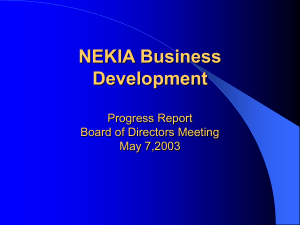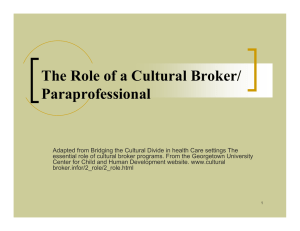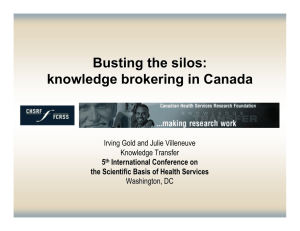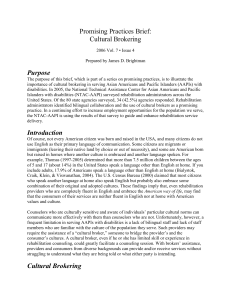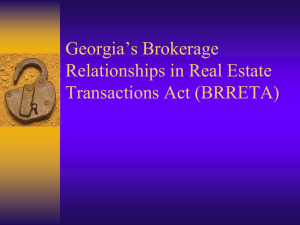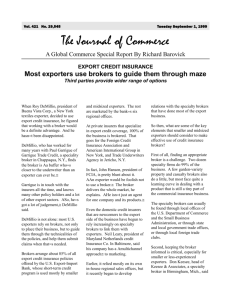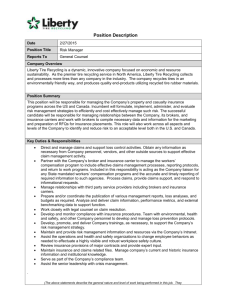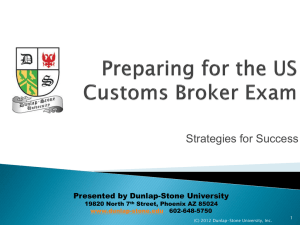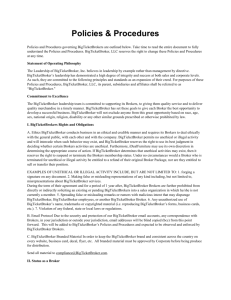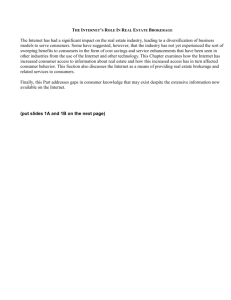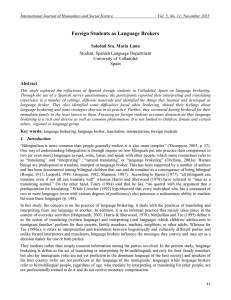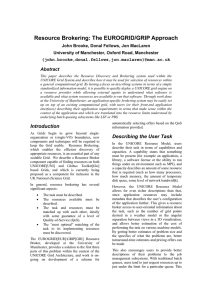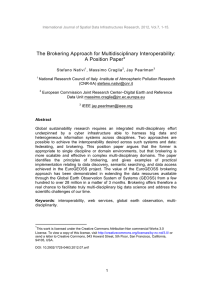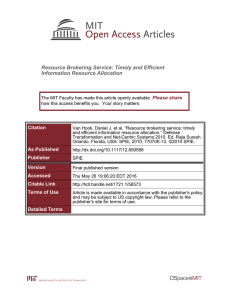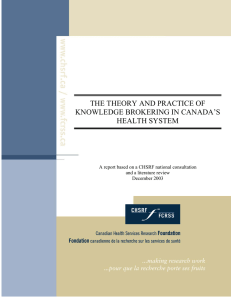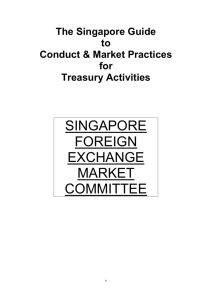Output 2: Handout
advertisement
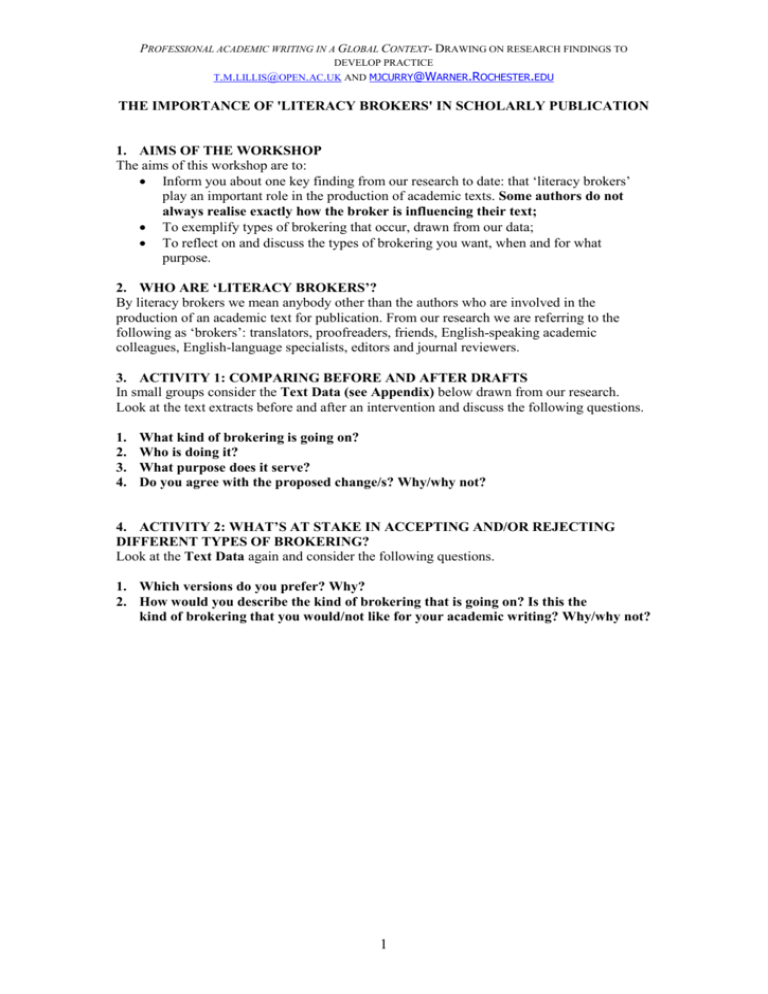
PROFESSIONAL ACADEMIC WRITING IN A GLOBAL CONTEXT- DRAWING ON RESEARCH FINDINGS TO DEVELOP PRACTICE T.M.LILLIS@OPEN.AC.UK AND MJCURRY@WARNER.ROCHESTER.EDU THE IMPORTANCE OF 'LITERACY BROKERS' IN SCHOLARLY PUBLICATION 1. AIMS OF THE WORKSHOP The aims of this workshop are to: Inform you about one key finding from our research to date: that ‘literacy brokers’ play an important role in the production of academic texts. Some authors do not always realise exactly how the broker is influencing their text; To exemplify types of brokering that occur, drawn from our data; To reflect on and discuss the types of brokering you want, when and for what purpose. 2. WHO ARE ‘LITERACY BROKERS’? By literacy brokers we mean anybody other than the authors who are involved in the production of an academic text for publication. From our research we are referring to the following as ‘brokers’: translators, proofreaders, friends, English-speaking academic colleagues, English-language specialists, editors and journal reviewers. 3. ACTIVITY 1: COMPARING BEFORE AND AFTER DRAFTS In small groups consider the Text Data (see Appendix) below drawn from our research. Look at the text extracts before and after an intervention and discuss the following questions. 1. 2. 3. 4. What kind of brokering is going on? Who is doing it? What purpose does it serve? Do you agree with the proposed change/s? Why/why not? 4. ACTIVITY 2: WHAT’S AT STAKE IN ACCEPTING AND/OR REJECTING DIFFERENT TYPES OF BROKERING? Look at the Text Data again and consider the following questions. 1. Which versions do you prefer? Why? 2. How would you describe the kind of brokering that is going on? Is this the kind of brokering that you would/not like for your academic writing? Why/why not? 1 PROFESSIONAL ACADEMIC WRITING IN A GLOBAL CONTEXT- DRAWING ON RESEARCH FINDINGS TO DEVELOP PRACTICE T.M.LILLIS@OPEN.AC.UK AND MJCURRY@WARNER.ROCHESTER.EDU 5. CONSIDERING DIFFERENT TYPES OF BROKERING TEXT: THREE MAIN TYPES OF BROKERS In our research we have found three main types of brokers who adopt different approaches to the text. These are illustrated in the Table below. Table: Brokers involved in academic text production: Textual practices and orientations CATEGORY OF TEXT EXTRACT BROKER COMMENT/ ORIENTATION BROKER ACTION We could say that the Query by broker 1.ACADEMIC target group PROFESSIONAL Isn’t this a bit problematic. participants are more What do you mean by middle-class than the middle class? Knowledge content random sample participants. 2. LANGUAGE PROFESSIONAL 3. NONPROFESSIONAL We used correlation analysis to examine the relationship between mental rotation ability and intelligence subtests (Table.2. And 3.). The result indicated an interference between verbal abilities and performance time of mental rotations. Reformulations made to text by broker Correlational analysis was used to examine the relationship between mental rotation ability and the intelligence subtests (Table 2 and 3). The result indicated a negative correlation between verbal abilities and performance time of mental rotations. The evaluation of the X methodology is discussed and recommendations for intervention activities are proposed. Section deleted by broker She enjoyed attending school and her school notes were very good at first grade. Corrections to lexical item and preposition made by broker She enjoyed attending school and her school marks were very good in the first grade. Research was undertaken on 5 locations. Correction to preposition made by broker. Research was undertaken in 5 locations. 2 Target journal conversations Disciplinary conversations Specialist discourse Sentence level changes/ corrections PROFESSIONAL ACADEMIC WRITING IN A GLOBAL CONTEXT- DRAWING ON RESEARCH FINDINGS TO DEVELOP PRACTICE T.M.LILLIS@OPEN.AC.UK AND MJCURRY@WARNER.ROCHESTER.EDU 6. REFLECTING ON YOUR OWN ACADEMIC WRITING PRACTICE What brokers do you use? Why? What kind of brokering do you want? Why? On the basis of the data and discussion today, how might you approach brokers in the future? For example, would you direct them to one particular kind of brokering rather than another-e.g. sentence level corrections rather than the content of your text? Appendix- TEXT DATA- authentic extracts from academic papers collected EXAMPLE 1: BEFORE From the Results section AFTER From the Results section We use correlation analysis to examine the relationship between mental rotation ability and intelligence subtests (Table.2. and 3.). The result indicated interference between verbal abilities and performance time of mental rotations. Correlational analysis was used to examine the relationship between mental rotation ability and the intelligence subtests (Table.2. and 3.). The result indicated a negative correlation between verbal abilities and performance time of mental rotations. EXAMPLE 2: BEFORE From the Introduction section AFTER From the Introduction section Different findings have been reported concerning the written language in LKS cases (29, 30, 31). The purpose of this study is to present a case of a child affected by the LK syndrome--- Various findings have been reported concerning the written language in LKS cases (29, 30, 31). The purpose of this study is to present the case of a child affected by the LK syndrome-- EXAMPLE 3: BEFORE From the Discussion section AFTER From the Discussion section ---sexual education in Slovakia is insufficient Sexual education in Slovakia appears to be insufficient 3 PROFESSIONAL ACADEMIC WRITING IN A GLOBAL CONTEXT- DRAWING ON RESEARCH FINDINGS TO DEVELOP PRACTICE T.M.LILLIS@OPEN.AC.UK AND MJCURRY@WARNER.ROCHESTER.EDU EXAMPLE 4: BEFORE From the Results section of the abstract AFTER From the Results section of the abstract Presented results outline the procedure that was used for conducting the RAR methodology and description of the structural, social and cultural context in the Army. Further are reported the key findings of general, specific (socio-cultural) and individual behaviour patterns concerning interaction of substance (alcohol) use and sexual behaviour. The evaluation of the RAR methodology are discussed and recommendations for intervention activities are proposed. The results of the study describe general, specific (socio-cultural) and individual behaviour patterns relating to the interaction of substance (alcohol) use and sexual behaviour. Recommendations are made about intervention that may be taken to foster safer sexual practices. Finally, advantages and limitations of the RAR methodology itself are discussed. 4
